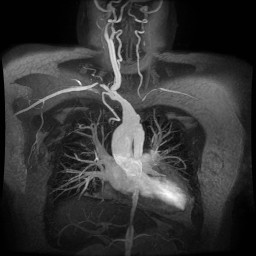- Joined
- Dec 29, 2012
- Messages
- 247
- Reaction score
- 4
68 yo male patient presents to your clinic with postprandial pain. X-ray below, whats the dx?
I am unknowledgable about this, why is microvesicular change important?
uc - lead pipe
microvesicular fatty change...narrows the diagnosis down quite a bit. Pregnancy and Reyes are notably and two of the few processes associated with microvesicular fatty change.
alcoholism is macrovesicular fatty change
yup, strong work
Alright, last one for me today...and it's another Endcrine question:
This woman is at risk for delivering a baby with what specific endocrine abnormality?
cretinism
Bingo, care to explain why/how it happens?
Bingo, care to explain why/how it happens?

2 different ecg patterns... what might be going on?
so nobody wanted to take a shot at this? the difference is in QT duration. Long QT can be a sign of hypocalcemia, short QT can be a sign of hypercalcemia
so nobody wanted to take a shot at this? the difference is in QT duration. Long QT can be a sign of hypocalcemia, short QT can be a sign of hypercalcemia
so nobody wanted to take a shot at this? the difference is in QT duration. Long QT can be a sign of hypocalcemia, short QT can be a sign of hypercalcemia

so nobody wanted to take a shot at this? the difference is in QT duration. Long QT can be a sign of hypocalcemia, short QT can be a sign of hypercalcemia
Yeah as with everyone else I figured this was the same person and for the life of me couldn't figure out what would cause paroxysmal long qt
I think a cool correlate to that would be arrythmic drugs class 1a and 3 can also cause that and thus torsaddes EXCEPT which drug?
edit: were you telling us the answer or no? lol
It depends on what the woman has. I just went ahead and assumed she wasn't in the U.S. although she might be so iodine deficiency in the baby doesn't allow thyroid hormone to be formed, which is important in brain and skeletal development. If it was Grave's, she could be taking anti-thyroid drugs or radioactive iodine. I think both PTU and Methimazole can cross placenta, but less likely with PTU. Also, idk if this is significant but grave's tissue probably takes in more iodine than a normal thyroid tissue and will leave the baby deficient but the mom in excess. If she was being treated for hashimoto's though, the baby wouldn't get it because i think thyroid hormone crosses the placental barrier (would that be a good question on step? lol). All can cause goiters tho
Edit: scratch that, untreated grave's would still provide T4 through the placental barrier
Iodine deficiency -> mom or baby can't make hormone
Untreated grave's -> baby will be ok as far as thyroid hormone
Treated grave's -> radioactive iodine will kill baby's thyroid. Methimazole is indicated in worse for baby than PTU (not sure if they specifically cause cretinism, but I know they are bad in pregnancy. confirm?)
Untreated hashimoto's -> Antibodies against TBG and thyroid peroxidase can cross placenta (I've read this somewhere, not sure how signfiicant)
Treated hashimoto's -> baby gets thyroid and iodine, will be good
ok damnit, I think I found a good one.
hx: veterinarian comes in with weird bumps. What is this?

Bacillary Angiomatosus (both from the veterinarian clue, and the fact that the link says so)

and whats the bacterium responsible for bacilliary angiomatosis?
Bartonella Henslae... what stain is it visible in?
Bartonella Henslae... what stain is it visible in?
no idea...
- Other Bartonella species are visible only with silver stains[[ (eg, Warthin-Starry, Steiner, Dieterle), if they stain at all. Bacillary forms also exist. These stains are not specific.
- Immunostaining can also aid in the diagnosis of early lesions or atypical manifestations of catscratch disease. Capnetti at al[28] found that immunohistochemical analysis was positive in 25% of cases, PCR in 38% of cases, and Steiner silver stain in 46% of cases of 22 patients with lymphadenopathy and histopathological findings compatible with catscratch disease.
- Late in the course of B henselae infection, organisms may not be found in areas of necrotizing granulomas.
Silver stain
Silver stain
To differentiate it from what? That it's commonly confused with
To differentiate it from what? That it's commonly confused with

no hx. what is it?
Central Pontine Demyelination? or is that the spinal body I'm looking at?
Central Pontine Demyelination? or is that the spinal body I'm looking at?
Complete hyditaform molar pregnancy?
Complete hyditaform molar pregnancy?
yea thats it... not bad at all with no background or history


ok, put it into imgur so the file name wouldn't give it away.
there is pathology there, it's a contrast angiogram.... anyone spot what is going on?
yup, good callsubclavian steal syndrome?
complete hyditaform molar pregnancy?

ok, put it into imgur so the file name wouldn't give it away.
there is pathology there, it's a contrast angiogram.... anyone spot what is going on?

ok, put it into imgur so the file name wouldn't give it away.
there is pathology there, it's a contrast angiogram.... anyone spot what is going on?
subclavian steal syndrome?

29 yo male with 2 month history of intermittent abdominal pain, fever, elevated Cr and urea nitrogen. Negative ANA and ANCA. Angiogram of SMA shown.
Is this what angiodysplasia looks like
